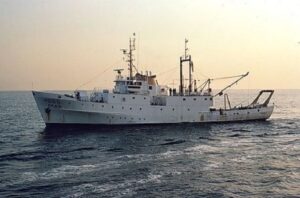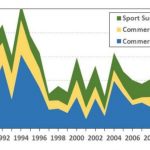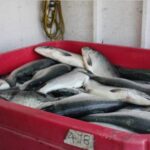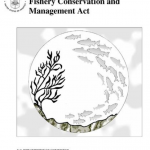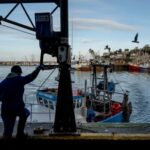Maximum Sustainable Yield: Just More Management Delusion or a Bureaucratic Con?
Dick Grachek
A note from Dick: Jim Lovgren’s comprehensive article on NOAA science and NOAA’s approach to Fluke management inspired me to tune up and post this piece I wrote on Maximum Sustainable Yield—the dehumanized, bookkeeping exercise that passes for the management approach of choice. (Warning: It’s a bit long, but I think it has relevance) Jim Lovgren – Fishery managers responsible for Summer Flounder mismanagement – click here
Maximum Sustainable Yield: Just More Management Delusion or a Bureaucratic Con?
Even if getting out from under the management fantasy of the “extinction delusion” could somehow become a reality, an essential overhaul of the basic goals of fishery management is necessary and must begin by asking the obvious—but totally neglected—question, what exactly is all this management supposed to accomplish, anyway? Maximum Sustainable Yield: Stable and Sustainable Stocks, Right? Well…actually, managing the fisheries to MSY is all wrong.
MSY accomplishes nothing more than stock population instability. One of the major mechanisms of this MSY approach is engineering the taking of large fish out of a population in some formulaic proportion to the young recruited into that particular stock. This is a naive and simplistic notion of stock dynamics. It completely ignores a myriad of natural or “biological-environmental” factors that govern fish survival and growth and population.
Michael Weber, special assistant to the chief of the National Marine Fisheries Service in 2002: “Like other, later scientific formulations that were incorporated in fisheries policy, the limitations of MSY… were largely ignored by decision makers and often by scientists. Among other shortcomings, these models assumed that the environment itself did not fluctuate and that interactions among fish populations had minimal effect. Neither assumption was borne out in reality.”
Carleton Ray, venerable and revered conservation scientist at the University of Virginia: “Science can be just as obstinate as any other field. And the traditionalists in science were the population dynamicists, who were very conservation-oriented, but felt the key was better use of MSY. In fact, when MSY first came around everyone thought it was a breakthrough in conservation, and it turned out to be one of the problems. Now it’s been shown, more or less, that we were right: In management, you can’t separate our animals from their environment.”
MSY actually works against stock health because it is the large slower growing fish that stabilize a stock. MSY by focusing on counting recruits and bartering their numbers for balancing out the taking of older larger fish renders populations consisting mainly of relatively small young fast growing fish—faster growth rate, looks good on fish stock health reports, looks like the stock is improving rapidly, but faster-growth means greater oscillations and greater unpredictability over the long run. A healthy stock is a stock with a stable slower-growing multi-year class population—not a hoard of confused rampaging adolescents eating themselves out of house and home.
This simplistic MSY stock assessment and management dynamic of counting young fish (a mission impossible to begin with) as barter for taking the larger fish results in the equally simplistic management idea that to control commercial and recreational fishing mortality is to control the health of the fish stocks. This assumes, incorrectly, that all other factors in the fishes’ natural environment are fixed or constant or non-existent.
Probably, the only element in the fishes’ environment that the regulators can comprehend, measure, and control is commercial and recreational fishing activity. So, if the “counted” young recruits don’t jive with the arbitrary bartering formula and correspond to the large fish taken, then it’s a clear case of “Overfishing”???
Yup, it certainly is… and so that’s where management will focus energy, funding, and enforcement! Stop the greedy and destructive fishermen form Overfishing!
Again, it’s apparent that NOAA is assessing and managing the stocks to the forgone conclusion that the stocks are in dire shape since the scientists can’t find any fish, and they can’t find any fish because they’re all gone, and they’re all gone because the handful of fishermen that are left (after catch shares consolidation), are overfishing. MSY generated assessments can prove it!
Actually, MSY is quite effective and does work very nicely—for the regulators, but not for anything else. It works by providing relatively friendly and easily digested bookkeeping data for convoluted stock assessment computer models. And the “overfishing” conclusions rendered by this bogus approach to stock population health become self-serving bureaucratic justification for jobs and academic claims to fame. And perhaps also a significant motivating factor for the popularity of MSY bungling, is that it also provides NOAA’s Eco-Non-Government Organization “partners” i.e., Pew, EDF, Oceana, NRDC, etc. a sweet marketing platform for donation harvesting. It’s simple: “…just give us funding and we’ll send in our battery of lawyers to stop the overfishing that is indicated by the MSY based analyses. Brilliant, eh?
A Better Idea: Respect the Resource, Respect the People Who Feed You, and Preserve the Small Boat Fleet or Let’s Get Back to Optimum Yield.
“[There is a]…critical role that sound science and good governance —that is, inclusive, transparent co-management between government, and industry and stakeholders — plays in ensuring the sustainability of fisheries.” Ecotrust Canada (intro. to “A Cautionary Tale”)
The fisheries can be successfully managed. With integrity, common sense, and clarity of purpose it can be done. Fishermen understand that successful effective management is absolutely necessary for the survival of the fish and the fishing communities; but clearly, micro-management, as currently practiced, is impossible.
The problems managing the complicated Northeast Multi-Species Fishery have to do with some very unrealistic ideas about fish and fishing at NOAA. Fisheries problems that are attributed to dwindling stocks and uncooperative rogue fishermen mis-reporting their catch are, in truth, most often created by this huge, detached, despotic, and external agenda-driven, and mismanaged, NOAA bureaucracy, unwieldy, inflexible, overwhelmed, confused, and inept. An agency that is NGO Lawsuit cowed, with a culture of entrenched and defensive conservative viewpoints will never be effective.
Fishing cannot be managed from sound-bites or marketing slogans created by environmental organizations with a prejudice and an agenda. Good scientific observation, accurate stock assessments, and intelligent co-governance do not result if there is a predisposition or a given blind allegiance to the postulate that “the fish are endangered due to illegal and immoral overfishing”.
Fishing also cannot be managed from an academic economist’s or biologist’s point of view only. Fishing is a multi-faceted issue and requires a multi-discipline approach, including sociologists, social-psychologists, social-anthropologists, and social-historians, and especially must include the fishermen and fish handlers whose lives will be directly and sometimes drastically affected by the outcome of the regulation decisions—and who have daily, first-hand vital information.
The words “men” and “women”, the humans, have to be put back and coupled with the term “fishers” (the neutered and dehumanized term so favored by the anti-fishing theorists). Fishing is an interaction between fish and people.
Optimum Yield (OY) is actually the stated goal of all this management, mandated by the original MSA (Magnuson-Stevens Act), or as earlier called, the MFCMA (Magnuson Fishery Conservation and Management Act).
Although never adequately defined, OY certainly includes the people aspect of the fisheries, i.e., considering the relevant ecological, economic, and social factors. The Act stated in Sec.3 (18): “The term ‘optimum’, with respect to the yield from a fishery, means the amount of fish – A) which will provide the greatest overall benefit to the Nation, with particular reference to food production and recreational opportunities; and B) which is prescribed as such on the basis of the maximum sustainable yield from such a fishery, as modified by any relevant economic, social, or ecological factor.”
In that above passage what seems most relevant to this discussion of MSY is that “The Act” clearly states “MSY as modified by economic, social, or ecological factors”.
In other words the “scientific” results of MSY oriented assessments become a preliminary starting out place and are to be mitigated by the non-scientific factors, economic, social, and ecological.
The National Standards of the Fishery Management Act required that all management plans take into account OY, or the non-scientific, the more human side, of the equation:
The Act Sec. 2 (b) (4), “… to provide for the preparation and implementation, in accordance with national standards, of fishery management plans which will achieve and maintain, on a continuing basis, the optimal yield from each fishery.”
Truly respecting OY and socio-economic-cultural and ecological aspects of the fisheries, would most likely encourage a diverse fleet of privately owned boats. These fishing operations have conservation systems and limits built in. They are restricted by weather and range and limited funding, by market prices, fuel and mechanical repair costs, and consequently they have unavoidable periods of down time (not-fishing). Due to narrow financial margins and weather safety issues, they can only fish for the stocks that are plentiful and within reach of their ports.
For these local family owned and funded operations, It is simply not financially viable for them to fish on depleted stocks or to stay at sea through dangerous weather conditions. These built-in restraints, coupled with cooperative-surveying and reasonably accurate science and assessments informing regulators, would be intelligent management and do much toward securing the health of the resource and the fishery.
However what we do have, that is passed off as “management”, is really the brandishing of the “overfishing” war cry, buttressed with faulty MSY assessment “proof”. This has moved management into the privatization and consolidation of the fishery through “Catch Shares”—as a measure to save the stocks from disappearing into “oceans of jellyfish”. The NOAA managers have also found the need to constantly tighten allowable catch quotas, or the amount of fish that fishermen are “allowed” to land, in order to thwart “rampant overfishing”— not to mention the NOAA/Oceana mandate of industry funded observers and monitors in order to enforce the ridiculous regulations. And oh yes, also the observers/monitors stop the millions upon millions of pounds of “Wasted Fish” discards— due to inefficient and greedy fishing practices, not disproportionate regulations.
Sadly, all this MSY borne assessments “fisheries managing” has resulted in the dismantling and disappearance of a large portion of the independent family owned and operated fishing fleets. And a fleet of many fishery-diverse “inefficient” boats would sustain the fish, preserve jobs, provide a vital healthy source of fresh food daily, and keep the traditional coastal fishing communities thriving.
The issues and problems facing the fishing industry are not insurmountable. But there needs to be some clarity and integrity, some honest and intelligent communication informing the purpose and long term goals for the fisheries. There can’t be hidden corporate agendas or personal ambition driven politics if the management endeavor is ever going to succeed in preserving the resource and the fishing communities.




































